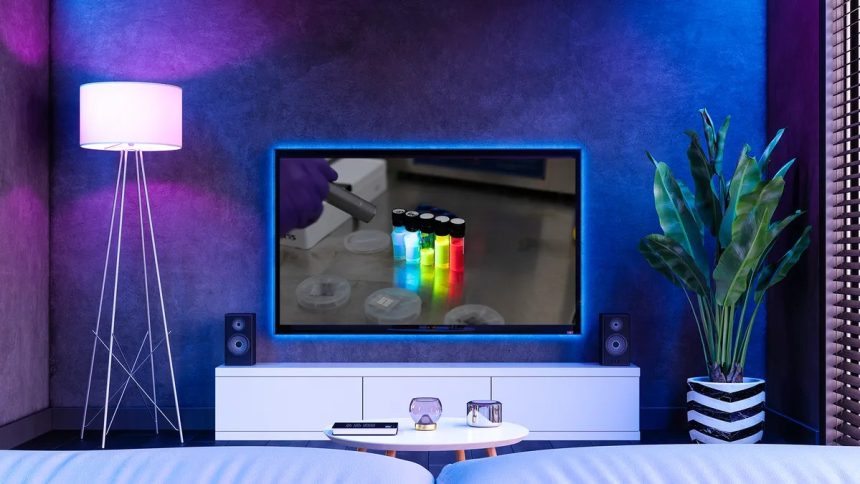Advancements in display technology have revolutionized the way we experience visual content. From CRT to plasma, LCD to OLED, each generation brought improvements in picture quality while also maintaining certain limitations. In recent years, the introduction of quantum dots enhanced LED, LCD, and OLED displays by making them brighter and more vibrant. However, quantum dots alone couldn’t overcome the inherent drawbacks of LCD and OLED technologies.
The next breakthrough came with direct-view quantum dots, also known as nanoLEDs, which represent the “holy grail” of quantum dot technology. Unlike previous technologies, nanoLED displays exclusively utilize quantum dots, eliminating the need for LCD or OLED components. This promises to deliver even better picture quality with minimal drawbacks. The emergence of nanoLED technology is on the horizon and holds tremendous potential for the future.
With nanoLED, the image is directly created by the quantum dot pixels, offering improved color reproduction, contrast, and brightness. These displays have the potential to provide an unparalleled viewing experience, with vibrant colors, deep blacks, and high dynamic range. Additionally, nanoLED technology may address issues such as screen burn-in and limited viewing angles associated with older technologies.
While nanoLED displays are not yet widely available, ongoing advancements and research suggest that this exciting technology could soon become a reality. As the future of display technology unfolds, nanoLED holds the promise of taking visual experiences to new heights, pushing the boundaries of what we thought was possible.
Quantum what?

Quantum dots are tiny particles that emit light when energized. In the context of display technology, they have been utilized as a layer in televisions and other displays to enhance color performance. Quantum dots come in different colors, with red and green being the most commonly used.
In traditional LCD displays, color filters are used to create different colors by selectively blocking certain wavelengths of light. This process results in a significant amount of energy wastage because the white backlight produces all colors, but only a fraction is utilized for each pixel. For example, if you have a red pixel, the TV still creates green, blue, and other colors, but these are blocked by the color filter, leading to inefficient energy consumption.
Quantum dots, on the other hand, have near-perfect efficiency in converting light. They can be excited by blue light emitted by LEDs or OLEDs and emit red and green light, creating a full range of colors. This eliminates the need for color filters and allows for more precise color reproduction, improved brightness, and reduced energy consumption. Quantum dots essentially convert blue light into a broader spectrum of colors, resulting in enhanced picture quality.
The integration of quantum dots as a color conversion layer in displays has been a significant advancement, providing more vibrant and accurate colors. This technology has been particularly popular in modern televisions, where quantum dots enhance the color gamut and contribute to a better viewing experience.
It’s important to note that the term “photoluminescent quantum dots” refers specifically to quantum dots that emit light when excited by photons, such as those used in display applications. Quantum dots have a wide range of applications beyond displays, including in medical imaging, solar cells, and quantum computing.
Quantum now

NanoLED, also known as electroluminescent quantum dots, represents a significant advancement in display technology. Unlike previous iterations of quantum dots that relied on photoluminescence (light excitation), nanoLEDs are electroluminescent, meaning they emit light when subjected to an electric current. This distinction marks a departure from being a supporting technology to becoming the star of the show.
By utilizing nanoLEDs, displays can be created by arranging pixels consisting solely of quantum dots. When a small voltage is applied to these quantum dot pixels, they emit light, allowing for the formation of a complete display. The key is to integrate a high density of nanoLED pixels and develop a mechanism to individually control and access each pixel.
Nanosys, a prominent manufacturer of quantum dots, has been at the forefront of developing this technology for several years. They have made significant progress in the production of nanoLEDs, as demonstrated by their prototypes and manufacturing facilities. NanoLEDs have also been referred to as EL-QD (electroluminescent quantum dots) or QD-LED (quantum dot LED).
The introduction of nanoLED technology holds immense potential for display quality, as it promises improved brightness, color accuracy, and energy efficiency. By eliminating the need for color filters or traditional LED backlights, nanoLED displays can deliver more vibrant and precise colors while consuming less power. The development of nanoLED displays represents a leap forward in display technology and opens up new possibilities for creating high-performance, next-generation displays.
Quantum when?

The introduction of nanoLED displays has been highly anticipated, and their availability in the market is gradually approaching. While the technology has been discussed for years, it made a significant appearance at CES 2023, where the first nanoLED displays were showcased. Nanosys, along with other prominent display manufacturers such as BOE, Samsung Display, Sharp, and TCL, have been actively exploring and experimenting with nanoLED technology.
Nanosys, as a leading quantum dot manufacturer, has provided insights into the timeline of nanoLED adoption. They anticipate the initial implementation of nanoLED displays in smaller devices like phones and tablets, followed by larger displays such as monitors and TVs. This progressive approach aligns with the expected trajectory of the technology.
The involvement of major industry players and their successful development of working prototypes further emphasizes the significance of nanoLED technology. Manufacturers like Nanosys, BOE, Samsung Display, Sharp, and TCL bring considerable expertise and influence to the field, generating curiosity and anticipation among consumers.
However, it is important to note that widespread availability of nanoLED displays in the consumer market may still take some time. Initially, quantum dot-enhanced LED LCD displays are likely to dominate the mid- and lower-end segments, while more advanced technologies like QD-OLED and mini-LED may also incorporate quantum dots to enhance their performance. Nonetheless, the future holds great promise for visually stunning displays, and the emergence of nanoLED technology will contribute to a wide range of impressive TV options.








